Maldon, Essex
Up to 1834
A workhouse was built in Maldon in around 1715 under the terms of the will of Thomas Plume (1630-1704) Archdeacon of Rochester, who left £200 for "erecting a workhouse for the poor of Maldon ...". Situated on Market Hill, it served the parishes of All Saints, St Peter's and St Mary's. According to the 1725 edition of An Account of Several Workhouses..., the building cost around £1,000 plus a further £200 for "goods and utensils".
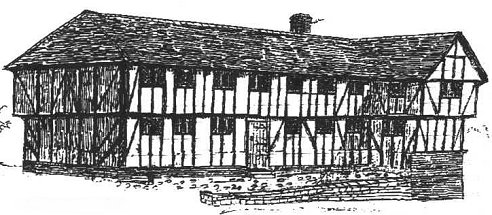
Maldon workhouse c.1719 (artist's impression).
© Peggy Edmond.
The building was extended in about 1750 with a back block at the west containing a basement, kitchen, cellars and Masters quarters, and the front at the east being remodelled. By 1810 there were approximately 50 inmates and 100 others receiving outdoor relief.
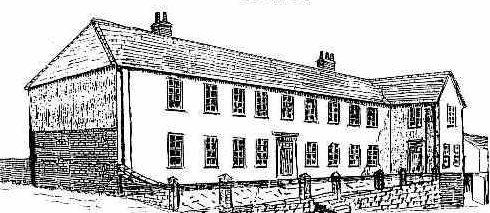
Maldon workhouse c.1750 (artist's impression).
© Peggy Edmond.
In 1725, the early workhouse directory, An Account of Several Workhouses..., noted the existence of a workhouse at Southminster.
A parliamentary report of 1777 recorded parish workhouses in operation at Burnham (for up to 24 inmates), Goldhanger (18), Maldon—St Mary (40), Purleigh (20), Southminster (30), Steeple (6), Stow Maries (10), Tillingham (6), Tollesbury (2), Tolleshunt Darcy (10), Tolleshunt Major (10), Great Totham (20), Little Totham (16), and Woodham Ferrers (30).
A cottage on The Street in Woodham Walter is said to have been used as the village poorhouse in the early 1800s.
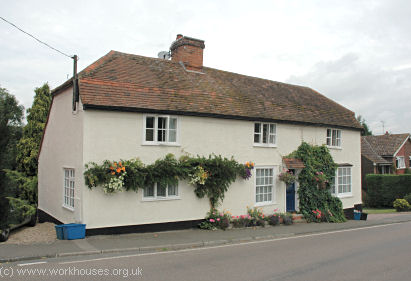
Woodham Walter former parish workhouse, 2006.
© Peter Higginbotham.
The Wickham Bishop parish workhouse operated in what is now Cherry Tree Cottage on Tiptree Road, Wickham Bishop.
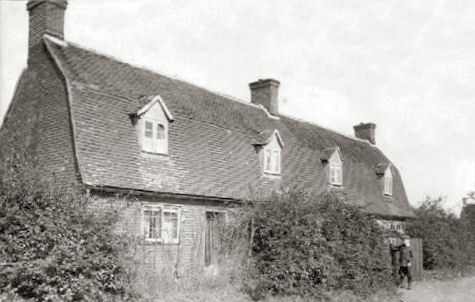
Wickham Bishop former parish workhouse.
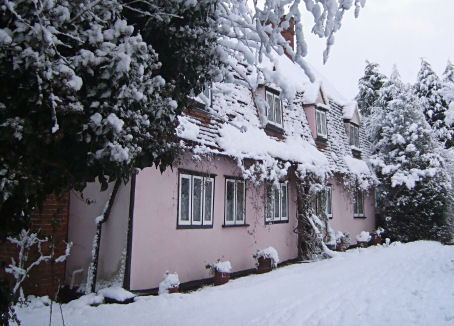
Wickham Bishop former parish workhouse, 2010.
© Bill Simpson.
After 1834
Maldon Poor Law Union was formed on 14th December 1835. Its operation was overseen by an elected Board of Guardians, 36 in number, representing its 32 constituent parishes as listed below (figures in brackets indicate numbers of Guardians if more than one):
County of Essex:
Althorn, Asheldham, Bradwell, Burnham (2), Cold Norton, Creeksea, Dengre, Goldhanger, Hazleigh, Heyridge, Langford, Latchingdon, Maldon All Saints, Maldon St Mary's (2), Maldon St Peter's (2), Mayland, Mundon, North Fambridge, Purleigh, St Lawrence, Southminster (2), Steeple, Stow Maries, Tillingham, Tollesbury, Tolleshunt D'Arcy, Tolleshunt Knights, Tolleshunt Major, Great Totham, Little Totham, Woodham Mortimer, Woodham Walter,
Later Additions (all from 1883): Great Braxted, Little Braxted, Ulting, Wickham Bishops.
The population falling within the Union at the 1831 census had been 18,917 — with parishes ranging in size from Hazleigh (population 119) to Maldon St Peter's (1,870). The average annual poor-rate expenditure for the period 1833-35 had been £14,236 or 15s.1d. per head of the population.
Initially, the new union took over the existing Maldon workhouse. The buildings were enlarged with a new top floor, porch and high wall being added. It could then hold 350 men, women and children supervised by Master and Matron and school teachers.
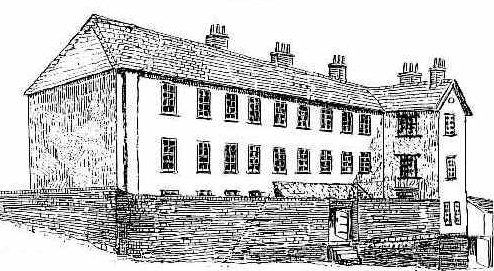
Maldon workhouse, c.1835 (artist's impression).
© Peggy Edmond.
Following the erection of the new workhouse in the 1870s, the old building was refronted, with new doors and bay windows added. It was sold at auction at Kings Head Maldon on 31 August 1875 in 2 lots: the main block and, separately, the outbuildings and school.
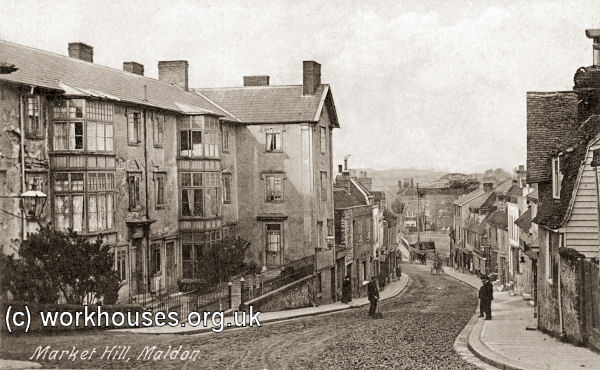
Former Maldon workhouse, c.1900.
© Peter Higginbotham.
The building was redeveloped into houses and flats during the 1980s and now bears a plaque commemorating its former history.
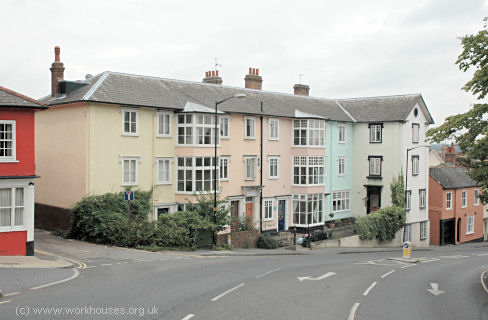
Maldon workhouse, 2006
© Peter Higginbotham.
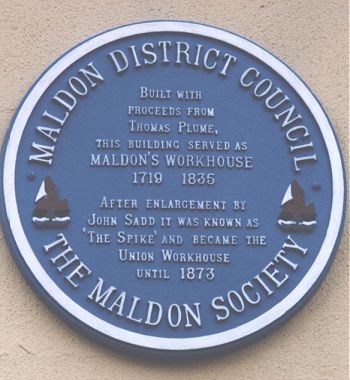
Maldon workhouse plaque 2003
© Peggy Edmond.
The New Workhouse
The new Maldon Union workhouse was erected in 1872-3 on a five-acre site on Spital Road in Maldon. It could accommodate 450 inmates and its construction cost around £20,000. The Tudor-style building was designed by Frederick Peck. Its location and layout are shown on the 1897 map below.
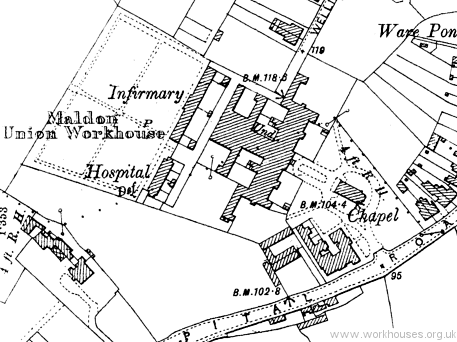
Maldon workhouse site, 1897.
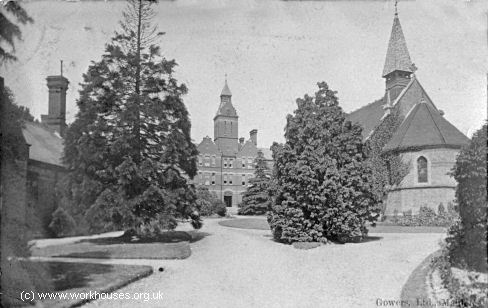
Maldon new workhouse, early 1900s.
© Peter Higginbotham.
A block at the site entrance contained a porter's lodge, board room, waiting room, master's quarters, probationary and tramps' wards.
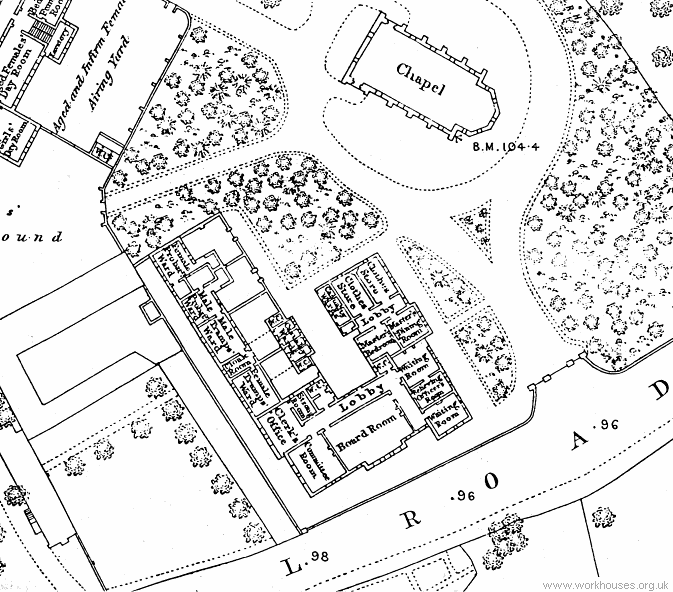
Maldon workhouse entrance block, 1873.
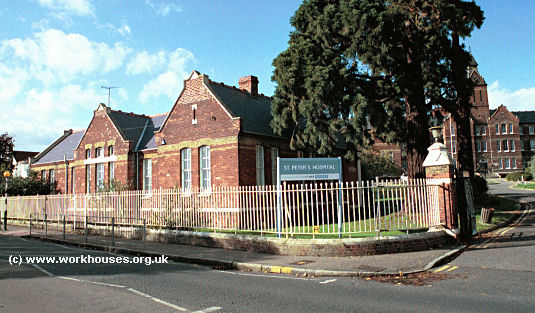
Maldon entrance from the south-east, 2000.
© Peter Higginbotham.
The main building contained administrative offices and dining-hall at its centre. Male inmates were accommodated to the north and females to the south.
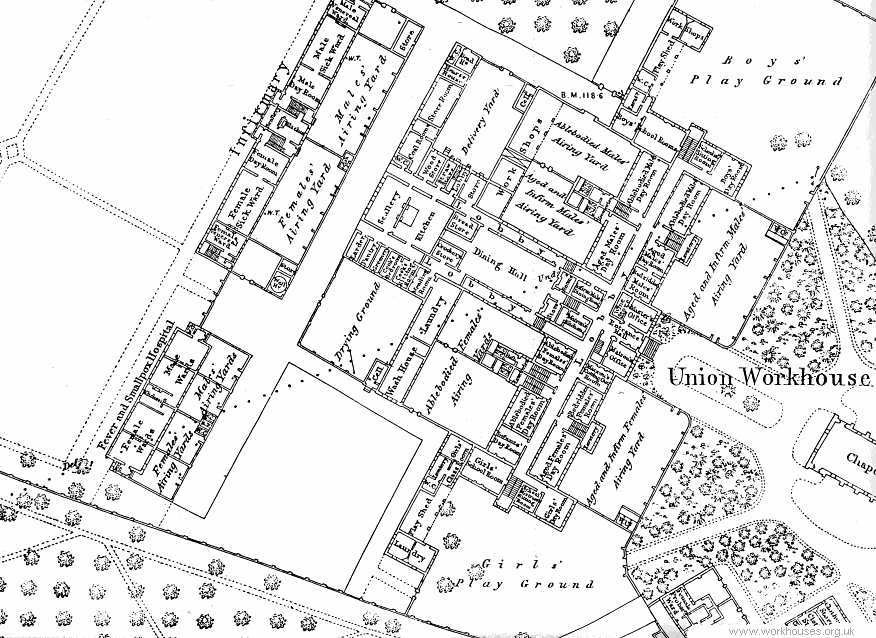
Maldon workhouse main block, 1873.
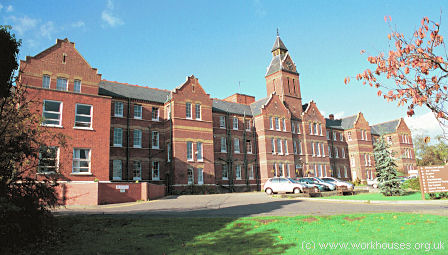
Maldon main building from the south-east, 2000.
© Peter Higginbotham.
To the rear of the main building were the kitchen, laundry, mortuary, and stores. A separate infirmary stood to the west of the workhouse.
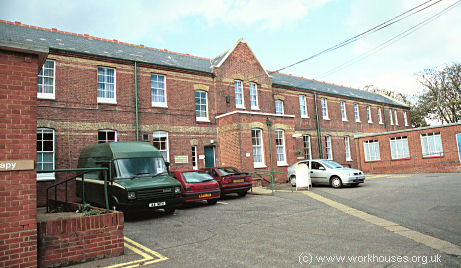
Maldon original infirmary block from the south-east, 2000.
© Peter Higginbotham.
A chapel was erected in the grounds at the front of the main building.

Maldon chapel from the south-east, 2000.
© Peter Higginbotham.
In December 1874, an explosion in the nurses' kitchen of the new workhouses' fever hospital caused considerable damage to the building. It was thought to have been caused by water in the circulating pipes being frozen and causing a build-up of steam in the boiler which then burst. The force of the explosion destroyes two walls separating the kitchen from the patientents' rooms, and also brought down the chimney which made two holes in the roof. There were no casualties, however.
After 1930, the workhouse was redesignated as a Public Assistance Institution. After 1948, it joined the National Health Service as St Peter's Hospital. In recent times, the lodge has been used as mental illness day unit, and the chapel as a staff social club.
Maldon Children's Homes
The Maldon Union operated a children's home at Tiptree. It occupied rented premises at the corner of Station Road and Church Road, formerly used as a temperance hotel. The much-altered building is now used as retail premises.

Temperance Hotel, Tiptree, early 1900s.
A property known as The Gables at 116 High Street in Maldon was also later used as children's accommdation.
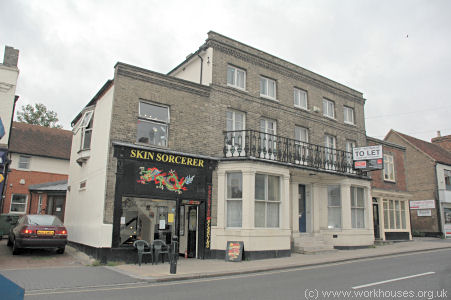
The Gables, 2006.
© Peter Higginbotham.
Staff
Inmates
Records
Note: many repositories impose a closure period of up to 100 years for records identifying individuals. Before travelling a long distance, always check that the records you want to consult will be available.
- Essex Record Office, Wharf Road Chelmsford CM2 6YT. Holdings include: Guardians' minutes (1835-1930); Ledgers (1835-1930); Births (1836-61); Deaths (1836-62, 1866-1914); Creed register (1900-14); Casuals' admissions and discharges (1914-25, 1932); Indoor relief lists (1839-1930); Workhouse medical relief books (1862-74); etc.
Bibliography
- Maldon Workhouse (1719-1875) by Peggy Edmond (ISBN 0 9536147) copies from St Clares Hospice 01621 857727. (Archive researches deposited with Maldon Archeological and Historical Group, Brickhouse Farm, 01245 222175.)
Links
- None.
Acknowledgments
- Many thanks to Peggy Edmond who has kindly allowed her researches on the old Maldon workhouse to be included here. Also to Bill Simpson for picture of Wickham Bishop.
Unless otherwise indicated, this page () is copyright Peter Higginbotham. Contents may not be reproduced without permission.


